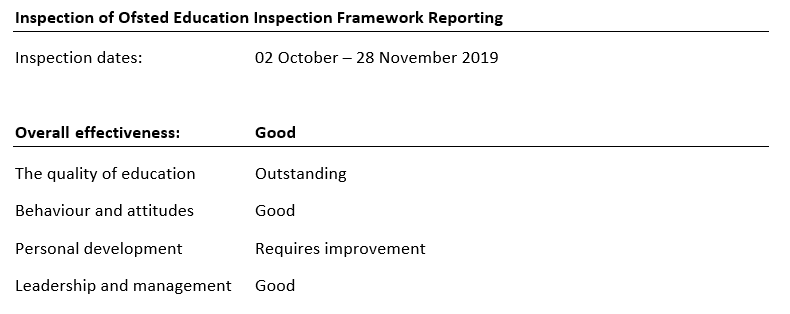
Does Ofsted’s new inspection framework support learners with SEND?
20/1/2020
I have spent the past couple of days reading Ofsted reports. A lot of Ofsted reports. Seven-hundred-and-sixty-six Ofsted reports to be precise. Why? Well, it’s been a whole term since Ofsted introduced their new Education Inspection Framework (EIF) and I wanted to see how the new Framework is (as far as reporting goes anyway) working out for learners with special educational needs and disabilities (SEND).
Reading 766 Ofsted reports has affected me a bit – I find myself grading my dinner (could do better), TV programmes (had high expectations) and the remaining Christmas decorations surviving the January chill (needs have not been met accurately). So, I am going to report to you my thoughts on the 766 Ofsted reports published to-date in the style of the reports I have been reviewing.

What is it like to read these reports?
Parents will benefit from the simplified style and tone of the reports. Ofsted have reduced the length and complexity of reports as part of the new EIF. However, this has reduced the level of written feedback to school leaders. As a result, they may not contain the detail required to meet their needs.
On occasion, the provision for pupils with special educational needs and/or disabilities (SEND) is not good enough. Sixteen reports do not mention SEND at all. In these reports – one Outstanding, two Requires Improvement (RI), and 13 Good – no comment is made about SEND provision. Ofsted should ensure that provision for these pupils are being addressed consistently well across all reports.
On average, reports contain 2.4 mentions of SEND provision. This is slightly higher in secondary (2.9) than primary (2.3).
Reports consistently mention SEND more when provision is weaker. Reports grading schools RI or Inadequate have a higher level of mentions (2.9 and 3.3 respectively). Ofsted should ensure that reports consistently identify and exemplify good practice as well as poor.
What do the reports do well and what do they need to do better?
Over two-thirds of reports provide only positive comments about SEND provision. This includes 449 reports where the school is rated Good, and 14 where the schools is rated Outstanding. However, it also includes 58 that are identified as requiring improvement. Overall, there is no clear correlation between positive feedback on SEND provision and Ofsted grade.
One in ten reports mention SEND only as an area for improvement. This includes reports where the school is rated as Good (31), as well as those that are RI (40) or Inadequate (7). Where provision is Good, poor quality SEND provision ought to limit the judgement. One Good report states “teachers do not check what pupils know and can do well enough. This means that too many pupils, including those who have fallen behind and those with special educational needs and/or disabilities (SEND), do not catch up quickly.”
SEND and ‘quality of education’ is a strength of the reports. Report authors are clearly interested in ‘ambitious curricula’ for SEND learners, ‘high expectations’ amongst staff and leaders, and ensuring ‘pupils achieve highly’.
SEND and ‘leadership and management’ is also well covered. School leaders, special educational need coordinators (SENCOs) and governors all participate in the inspection process. Comments and recommendations are often targeted at this group of adults.
SEND and ‘personal development’ is most likely to be included in positive feedback. In a small number of cases, SEND is only mentioned in reports as part of phrases such as “this includes those pupils who are disadvantaged and those with special educational needs and/or disabilities (SEND).” Report authors must ensure that SEND reporting is not used as a platitude rather than as a meaningful judgement.
‘Behaviour management’ was an area where concern had previously been expressed. However, we found that the current EIF reports rarely links SEND with behaviour.
Safeguarding
The arrangements for safeguarding are effective.
No report identified SEND as a safeguarding risk. Two reports identified SEND safeguarding as a strength. One report states “leaders… understand that pupils with SEND may experience different risks to their safety compared with others and tailor the training they provide for staff to address this.”
What does the reporting need to do to improve?
- The simple reporting style does not contain the detail required to meet the needs of school leaders. On occasion, reports do not contain any information about SEND provision. Ofsted should ensure that provision for these pupils is being addressed consistently well across all reports.
- Ofsted must ensure that reports identify and exemplify good practice in SEND, as well as poor. They should ensure that information about SEND is communicated clearly and regularly in reports. Report authors must ensure that SEND reporting is not used as a platitude rather than as a meaningful judgement.
- Where provision is Good, poor quality SEND provision ought to limit the judgement available.
Information about this review
- This review was funded by Nasen.
- I analysed 766 inspection reports from primary and secondary schools. Special schools, nurseries and PRUs were excluded from the analysis. Monitoring visits were also excluded.
- I searched reports for mention of ‘SEN’. When ‘SEN’ was not present, I searched for ‘needs’ and ‘special’.
- The number of mentions was recorded, and the type of mention was coded as either ‘quality’, ‘behaviour’, ‘leadership’, ‘personal’ or ‘safeguarding’. Type of mention was also coded as ‘positive’, ‘negative’ or ‘neutral’.
- Analysis was conducted by phase and judgement.
Review team
Karen Wespieser – Director of Operations, Driver Youth Trust
